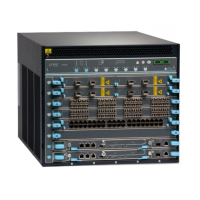the color coding for the leads on the power cables that attach to the
terminal studs on each power supply.
9. Remove the washers and nuts from each DC power input terminal, using a 7/16-in.
[11-mm] nut driver or socket wrench.
10. Secure each power cable lug to the terminal studs, first with the flat washer, then
with the split washer, and then with the nut (see Figure 53 on page 187). Apply between
23 lb-in. (2.6 Nm) and 25 lb-in. (2.8 Nm) of torque to each nut. Do not overtighten the
nut. (Use a 7/16-in. [11-mm] torque-controlled driver or socket wrench.)
a. Secure the positive (+) DC source power cable lug to the RTN (return) terminal.
b. Secure the negative (–) DC source power cable lug to the –48V (input) terminal.
CAUTION: Ensure thateach power cablelugseatsflush against the surface
of the terminal block as you are tightening the nuts. Ensure that each nut
is properly threaded onto the terminal stud. You must be able to spin the
nut freely with your fingers when it is first placed onto the terminal stud.
Applying installation torque to the nut when improperly threaded may
result in damage to the terminal stud.
CAUTION: The maximum torque rating of the terminal studs on the DC
power supply is 36 lb-in. (4.0 Nm). The terminal studs may be damaged
if excessivetorque is applied. Use only a torque-controlled driver or socket
wrench to tighten nuts on the DC power supply terminal studs.
CAUTION: The DC power supplies in PEM0 and PEM1 must be powered
by dedicated power feeds derived from feed A, and the DC power supplies
in PEM2 and PEM3 must be powered by dedicated power feeds derived
from feed B. This configuration provides the commonly deployed A/B feed
redundancy for the system.
For information about connecting to DC power sources, see “DC Power Supply
Specifications for EX9208 Switches” on page 96.
11. Route the power cables along the cable restraint toward the left or right corner of the
chassis. If needed, thread plastic cable ties, which you must provide, through the
openings on the cable restraint to hold the power cables in place.
12. Replace the clear plastic cover over the terminal studs on the faceplate.
13. Verify that the power cabling is correct, that the cables are not touching or blocking
access to switch components, and that they do not drape where people could trip on
them.
Copyright © 2017, Juniper Networks, Inc.186
EX9208 Switch Hardware Guide

